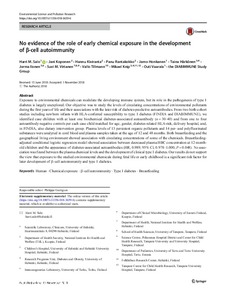No evidence of the role of early chemical exposure in the development of β-cell autoimmunity
Salo H.M.; Koponen J.; Kiviranta H.; Rantakokko P.; Honkanen J.; Härkönen T.; Ilonen J.; Virtanen S.M.; Tillmann V.; Knip M.; Vaarala O.; DIABIMMUNE Study Group
https://urn.fi/URN:NBN:fi-fe2021042720427
Tiivistelmä
Exposure to environmental chemicals can modulate the developing immune system, but its role in the pathogenesis of type 1 diabetes is largely unexplored. Our objective was to study the levels of circulating concentrations of environmental pollutants during the first years of life and their associations with the later risk of diabetes-predictive autoantibodies. From two birth-cohort studies including newborn infants with HLA-conferred susceptibility to type 1 diabetes (FINDIA and DIABIMMUNE), we identified case children with at least one biochemical diabetes-associated autoantibody (n = 30–40) and from one to four autoantibody-negative controls per each case child matched for age, gender, diabetes-related HLA-risk, delivery hospital, and, in FINDIA, also dietary intervention group. Plasma levels of 13 persistent organic pollutants and 14 per- and polyfluorinated substances were analyzed in cord blood and plasma samples taken at the age of 12 and 48 months. Both breastfeeding and the geographical living environment showed association with circulating concentrations of some of the chemicals. Breastfeeding-adjusted conditional logistic regression model showed association between decreased plasma HBC concentration at 12-month-old children and the appearance of diabetes-associated autoantibodies (HR, 0.989; 95% Cl, 0.978–1.000; P = 0.048). No association was found between the plasma chemical levels and the development of clinical type 1 diabetes. Our results do not support the view that exposure to the studied environmental chemicals during fetal life or early childhood is a significant risk factor for later development of β-cell autoimmunity and type 1 diabetes.
Kokoelmat
- Rinnakkaistallenteet [27094]
